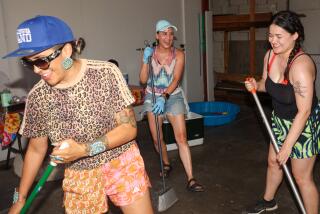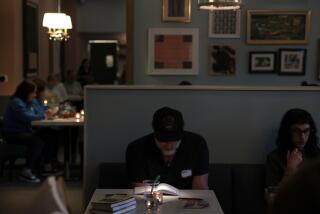Dealing With Disabilities : Clooney ‘Clubhouse’ in L.B. Helps Brain-Injury Victims Become Independent
- Share via
The stories have a similar ring.
GG Cree was a sophomore at USC six years ago when she fell off a cliff while hiking with friends in Malibu. “It knocked me crazy,” said Cree, 26, who spent three months in a coma and today speaks with great difficulty, has little short-term memory and must exert a Herculean effort to accomplish even the simplest of tasks.
Sheila Polzin was also 26 the day she threw herself on top of a car driven by a boyfriend with whom she had been fighting. The boyfriend drove off, throwing Polzin head first to the pavement. Today, at 35, she has double vision, speaks very slowly and finds it difficult to walk.
And Sandi Holvey was a 27-year-old emergency room nurse about to apply to medical school when, while water skiing on a lake near Modesto eight years ago, she was struck in the head by a tree branch that the boat had hit and thrown back at her. “My life is very different now,” said Holvey, who is painfully learning to type on a computer and still mourns the loss of many of her friends who could not adapt to her disability.
Unable to live independently or hold even menial jobs, all three are cared for by their parents. For the last three months, however, they have had a place to spend their days that--for the first time since their accidents--holds out the hope of at least minimal rehabilitation. It is the Betty Clooney Center, an unusual non-residential “clubhouse” in Long Beach that many believe is breaking new ground in dealing with the disabilities of severely brain-injured people.
“(This kind of injury) is so devastating to a family,” said Rosemary Clooney, the singer who helped found the center and is its major spokeswoman. “It changes lives in a split second. Parents can’t shoulder this alone.”
Clooney first became interested in the problem in 1976, when her sister and former singing partner, Betty--for whom the center is named--died of a brain aneurysm at 45. That interest was intensified four years later, she said, when Holvey, who is Clooney’s second cousin, had her water skiing accident.
“It was very, very difficult,” Clooney remembers of the accident and its aftermath. “We wanted somewhere for (her) to do the best that (she) could.”
At the center, located in a 5,000-square-foot building owned by the nearby Memorial Medical Center of Long Beach, Holvey and 21 other “members” from 17 to 50 spend most of their days performing all of the tasks necessary to maintaining the center itself. Those tasks include answering the telephone, typing letters, putting out a monthly newsletter called The Clooney Chronicle, maintaining resource files, conducting entry interviews and running a clubhouse kitchen called the Clooney Cafe.
“Our main goal is to get them back in the community and as independent as possible,” said program director Cathy DeMello, one of six staffers who supervise the work. By creating a situation in which members can learn useful skills in a non-competitive environment, she said, the center hopes to gradually build up their confidence so they can one day re-enter the work force. “This is a real-world environment,” she said. “(The members) are needed and expected. They’re not just practicing typing, they’re (contributing) it.”
Members Prepare Garden
Among the center’s more ambitious projects is a vegetable and herb garden planned on an adjacent one-fifth-acre plot already being prepared for planting by a team of members. Eventually, DeMello said, the vegetables will be used in the kitchen and the herbs sold commercially to help cover expenses and pay the members for their work.
The center, which operates on about $250,000 a year, is supported by various grants, private donations and the income from an annual concert put on by the 3-year-old nonprofit Betty Clooney Foundation for the Brain Injured. According to DeMello, members are not charged for their participation in center activities.
Eventually, she said, staffers hope to serve as many as 60 brain-injured individuals and be able to offer low-cost housing in which they can live semi-independently under staff supervision.
“The biggest barrier to their functioning is the inability to hold on to new information,” DeMello said of her charges, most of whom suffer from short-term memory loss. Seventy percent of the estimated 700,000 to 2 million brain injuries occurring in the United States each year result from automobile or motorcycle accidents, she said. The center’s membership also includes the victim of a snow skiing accident, an individual whose brain was damaged from lack of oxygen during an accidental hanging and a person who was hit over the head with a board by a mugger in New York City.
Unusual in Its Approach
While many programs throughout the country aim to rehabilitate brain-damaged patients, said Silvana Guerci-Lena, a spokeswoman for the National Head Injury Foundation, she knows of no others based on the Clooney “clubhouse” model, although the concept has been used for patients with psychiatric disorders.
Judging from the members’ comments, the approach seems to be working just fine.
“The center has given me a place to come where I know that everybody is my friend,” said Daniel Bunker, 26, who was working as a store clerk six years ago when the pickup truck in which he was riding collided with another vehicle, throwing him head first against a curb. Today, capable only of slurred speech and unable to concentrate on anything for more than a few minutes, he works in the center’s garden and paints offbeat pictures of a character called Marvin the Monster which adorn the facility’s walls.
“Each day is a new adventure,” said Bunker, fingering the loose-leaf notebook that he calls “my memory” and carries with him everywhere.
Said Holvey: “This gives you the feeling of accomplishing something positive for yourself and the whole head-injured population. Hopefully, we’re opening a door here.”


